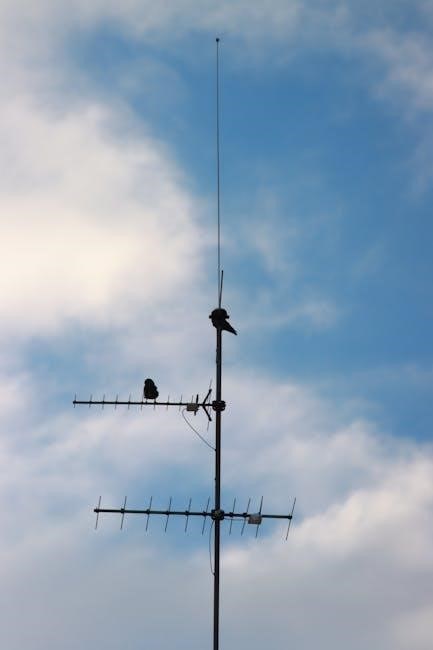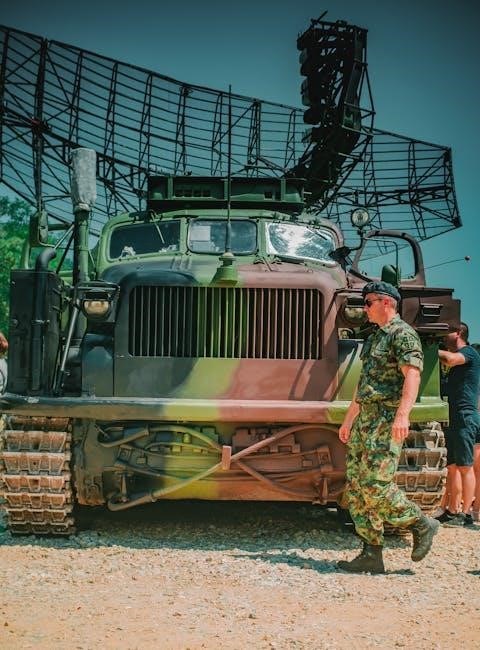Visual signals are critical for communication in military operations‚ especially when electronic methods fail. Ground guides ensure safe vehicle maneuvering in low-visibility conditions‚ relying on standardized signals for efficiency and security. The updated US Army Visual Signals Manual emphasizes the importance of these methods for clear and rapid communication across units.
Definition and Purpose of Visual Signals
Visual signals are non-verbal communication methods that rely on sight to convey messages. They include gestures‚ flags‚ lights‚ and ground markings‚ designed to transmit information quickly and clearly. The primary purpose of these signals is to ensure effective communication when verbal or electronic methods are impractical or unavailable. They are essential for coordinating actions‚ maintaining safety‚ and directing movements in various military scenarios. Standardization of these signals‚ as outlined in the US Army Field Manual (FM 21-60) and Training Circular (TC 3-21.60)‚ ensures consistency and clarity across all units. Visual signals play a vital role in enhancing operational efficiency and reducing misunderstandings‚ particularly in high-stress or low-visibility environments. Their simplicity and reliability make them a cornerstone of military communication‚ enabling seamless coordination between personnel and units.
Importance of Ground Guide Signals in Military Operations
Ground guide signals are indispensable in military operations‚ particularly in environments with limited visibility or when electronic communication is compromised. They serve as the primary means of directing vehicle movements‚ ensuring safety‚ and preventing accidents. Ground guides act as the “eyes” for vehicle operators‚ providing critical direction through hand gestures‚ flags‚ or painted markings. Their role is vital in maintaining operational continuity and coordination‚ especially in congested or confined areas. The standardized signals outlined in the US Army Visual Signals Manual ensure clarity and consistency‚ enabling precise communication. These signals are not just practical but essential for maintaining tactical advantage and operational efficiency. Their effectiveness relies on rigorous training and adherence to established protocols‚ making them a cornerstone of military communication in diverse operational scenarios.

Types of Visual Signals
Visual signals include arm-and-hand signals‚ flag signals‚ pyrotechnic signals‚ and ground-to-air signals‚ each designed for rapid communication over short distances in military operations.
Arm-and-Hand Signals
Arm-and-hand signals are fundamental in military communication‚ offering clear and precise instructions. Soldiers use specific gestures to convey messages‚ such as pointing directions or signaling halts. These signals are standardized in the US Army Visual Signals Manual‚ ensuring consistency across units. For instance‚ a palm-out hand can indicate a stop‚ while extended arms may signal width or distance. Ground guides rely heavily on these signals to direct vehicle movements safely‚ especially in low-visibility environments. Training in arm-and-hand signals is rigorous‚ emphasizing accuracy and speed to prevent misunderstandings. This method is essential when electronic communication is unavailable‚ ensuring seamless coordination and maintaining operational effectiveness.
Flag Signals
Flag signals are a vital component of visual communication in military operations‚ enabling effective transmission of commands over longer distances. The use of colorful flags ensures visibility‚ even in challenging conditions. Red and orange flags are often employed for their high visibility‚ signaling critical commands such as “stop” or “go.” These flags are strategically positioned to convey precise instructions‚ ensuring clarity and reducing ambiguity. Their versatility allows them to be used in various operational scenarios‚ from ground maneuvers to air support coordination. Standardized flag signals are outlined in the US Army Visual Signals Manual‚ ensuring uniformity across all units. This method is particularly valuable when electronic communication is limited‚ providing a reliable means of conveying essential information. Flag signals thus play a crucial role in maintaining operational efficiency and safety within military contexts.
Pyrotechnic Signals
Pyrotechnic signals are a reliable method of visual communication‚ utilizing flares‚ smoke‚ and other pyrotechnic devices to convey critical information. These signals are highly visible and effective in both day and night operations‚ making them ideal for scenarios where traditional methods may fail. Pyrotechnic signals are commonly used to mark positions‚ signal urgency‚ or indicate operational status. For instance‚ colored smoke can designate safe zones or landing areas‚ while flares can signal the start or stop of maneuvers. Their widespread visibility ensures that commands are understood across vast or obscured environments. Standardized in the US Army Visual Signals Manual and Training Circular 3-21.60‚ pyrotechnic signals provide a dependable means of communication‚ enhancing operational safety and coordination. Their versatility and reliability make them a cornerstone in military visual signaling systems‚ particularly in high-stakes or low-visibility conditions.
Ground-to-Air Signals
Ground-to-air signals are essential for establishing clear communication between ground units and aircraft. These signals are designed to be easily recognizable from the air‚ ensuring effective coordination during operations. Common methods include the use of brightly colored panels‚ flares‚ and smoke to mark positions or convey messages. For example‚ smoke signals can indicate landing zones or enemy positions‚ while flares can signal the need for immediate support. The US Army Visual Signals Manual and Training Circular 3-21.60 provide standardized guidelines for these signals‚ ensuring consistency and clarity. Ground-to-air signals are particularly crucial in scenarios where radio communication is unreliable or unavailable. Their effectiveness relies on proper training and precise execution‚ making them a vital tool for maintaining operational harmony between ground forces and air support units in dynamic and challenging environments.

Ground Guide Signals
Ground guide signals are crucial for safe vehicle maneuvering in low-visibility environments. They rely on clear hand gestures and visual markers to direct operators‚ ensuring precision and coordination. Proper training and communication are essential for effective ground guiding‚ as outlined in the updated US Army Visual Signals Manual‚ which emphasizes secure and efficient operations.

Role of Ground Guides in Vehicle Maneuvering
Ground guides serve as the vehicle operator’s eyes in low-visibility or confined areas‚ ensuring safe and precise maneuvering. Using hand signals‚ flags‚ or painted markings‚ they direct operators to avoid obstacles and maintain alignment. Their role is critical in environments like convoys‚ construction zones‚ or combat scenarios‚ where clear communication is vital. Proper guidance prevents accidents‚ protects personnel‚ and ensures equipment is positioned correctly. The ground guide’s actions must be deliberate and visible‚ adhering to standardized signals outlined in the US Army Visual Signals Manual. Effective coordination between the guide and operator is essential for mission success and safety. This role underscores the importance of visual communication in military operations‚ particularly when electronic methods are unreliable or unavailable.
Training and Coordination for Effective Ground Guiding
Effective ground guiding requires rigorous training and seamless coordination between guides and vehicle operators; Soldiers must master standardized visual signals‚ such as hand gestures‚ flag movements‚ and ground markings‚ to ensure clear communication. According to the US Army Visual Signals Manual‚ practice in various scenarios‚ including low-light conditions‚ is essential. Coordination drills enhance trust and understanding‚ enabling quick decision-making during maneuvers. Training circulars like TC 3-21.60 provide detailed guidance‚ emphasizing the importance of precision and consistency. Regular exercises and feedback sessions help refine these skills‚ ensuring that ground guides and operators work as a cohesive team. This training is critical for maintaining safety and operational efficiency‚ especially in high-stress environments where miscommunication could lead to accidents or mission failure.
Safety Protocols for Ground Guides
Safety protocols for ground guides are paramount to prevent accidents and ensure operational success. Ground guides must wear high-visibility clothing‚ such as reflective vests or armbands‚ to remain easily visible to vehicle operators. They should position themselves at a safe distance from moving equipment‚ avoiding blind spots. Clear communication through standardized signals is essential to prevent misunderstandings. Guides must stay alert to their surroundings‚ anticipating potential hazards like uneven terrain or obstacles. Protocols also include ensuring vehicles operate at reduced speeds in low-visibility or congested areas. Regular safety briefings and adherence to established guidelines‚ as outlined in the US Army Visual Signals Manual‚ are critical. These measures ensure the safety of both ground guides and vehicle operators‚ minimizing risks during maneuvers. Adhering to these protocols is non-negotiable for maintaining operational integrity and safeguarding personnel.

Standardization of Visual Signals
Standardization ensures clear communication and consistency in military operations. The US Army Field Manual (FM 21-60) and Training Circular (TC 3-21.60) provide standardized methods and protocols for visual signals‚ ensuring reliability and efficiency across units.
US Army Field Manual (FM 21-60) Overview
The US Army Field Manual (FM 21-60) serves as the primary reference for visual signals‚ outlining standardized methods for communication. It covers various types of signals‚ including arm-and-hand‚ flag‚ pyrotechnic‚ and ground-to-air signals‚ ensuring consistency across operations. The manual emphasizes the importance of clear and rapid communication‚ particularly in environments where electronic systems may fail. It provides detailed guidance on the use of visual signals for ground units‚ Army aviation‚ and supporting elements. FM 21-60 also highlights the role of ground guides in vehicle maneuvering‚ ensuring safety and efficiency in confined or low-visibility areas. Regular updates to the manual reflect evolving operational needs‚ ensuring that visual signals remain a reliable and secure method of communication in modern military scenarios.
Training Circular (TC 3-21.60) as a Reference Guide
Training Circular (TC) 3-21.60 is a comprehensive guide that standardizes visual signals for the US Army‚ ensuring consistency in communication. It supersedes earlier manuals and provides detailed instructions for soldiers to master visual signaling techniques. The circular covers various signals‚ including arm-and-hand gestures‚ flag usage‚ and pyrotechnic signals‚ all designed to convey prearranged messages quickly and securely. It also emphasizes the role of ground guides in vehicle maneuvering‚ offering practical techniques to enhance safety and efficiency. TC 3-21.60 serves as an essential training tool‚ helping soldiers develop proficiency in visual communication. Regular updates ensure the manual remains relevant‚ addressing evolving operational needs and maintaining secure communication methods when electronic systems are unavailable. This circular is a vital resource for maintaining effective and reliable visual signaling in military operations.
Updates to the Visual Signals Manual
The recent updates to the US Army Visual Signals Manual reflect the evolving needs of modern military operations. These updates mark the first major revision in over three decades‚ incorporating advancements in technology and operational requirements; The manual now includes new standardized signals for ground-to-air communication‚ enhanced protocols for low-visibility environments‚ and improved methods for ensuring secure communication. Additionally‚ the updated manual emphasizes the integration of visual signals with electronic communication systems‚ providing a layered approach to ensure reliability. These changes are designed to maintain the effectiveness of visual signals in contemporary operational scenarios‚ addressing challenges such as electromagnetic interference and the need for rapid‚ precise communication. The updates underscore the enduring importance of visual signals as a critical component of military communication strategies.

Practical Applications of Visual Signals
Painted ground markings‚ flags‚ and lights are strategically used for clear communication. Hand gestures and pyrotechnics enhance coordination‚ ensuring safety and efficiency in military operations‚ especially in low-visibility conditions.
Use of Painted Markings on the Ground
Painted markings on the ground serve as essential visual signals for guiding military vehicles and personnel. These markings are standardized to ensure clarity and consistency‚ often used in areas with limited visibility. They include arrows‚ symbols‚ and letters that direct vehicle movement and identify safe paths. According to the US Army Visual Signals Manual‚ such markings are crucial for maintaining order and safety during operations. They are particularly effective in confined spaces where other signals may be obstructed. The use of bright‚ contrasting colors enhances visibility‚ making them easily recognizable. Painted markings also complement hand gestures and flag signals‚ providing redundant communication methods. Their durability ensures they remain effective even in challenging environmental conditions‚ making them a reliable tool for ground guides and vehicle operators alike. This method is widely adopted across military operations for its simplicity and effectiveness.
Strategic Placement of Flags and Lights
Flags and lights are vital components of visual signals‚ used to convey critical information in military operations. Their strategic placement ensures maximum visibility and effectiveness. Flags are often positioned at key points such as vehicle paths or assembly areas‚ while lights are used to signal during low-light conditions; According to the US Army Visual Signals Manual‚ these tools are essential for guiding personnel and vehicles safely. The colors and patterns of flags are standardized to avoid confusion‚ with specific meanings assigned to each. Lights‚ often mounted on vehicles or stationary objects‚ provide clear directional cues. Their strategic use enhances communication‚ particularly in environments where other signals may be obscured. This method is integral to maintaining order and ensuring the safety of troops during maneuvers‚ making it a cornerstone of effective ground guidance and operational success. Proper training ensures their placement is both efficient and secure.
Hand Gestures for Communication
Hand gestures are a fundamental aspect of visual signals‚ enabling silent and precise communication in military operations. These gestures are standardized to ensure clarity and consistency across units. Soldiers are trained to use specific movements‚ such as extending arms or making specific shapes with the hands‚ to convey messages. For instance‚ a “telephone gesture” near the mouth signals the need to communicate. These gestures are particularly useful in noisy environments or when electronic communication is unavailable. The US Army Visual Signals Manual outlines a comprehensive set of hand gestures‚ ensuring all personnel understand their meanings. Proper training is essential to master these signals‚ as misinterpretation can lead to errors. Hand gestures are a reliable and efficient method of communication‚ complementing other visual signals like flags and lights. Their simplicity and effectiveness make them indispensable in maintaining operational coordination and safety. Regular drills ensure soldiers are proficient in their use‚ enhancing overall readiness.


Challenges and Limitations
Visual signals face challenges like limited visibility conditions and reliance on line-of-sight. They also have limitations when electronic communication is unavailable‚ requiring fallback methods for secure operations.
Dependency on Visibility Conditions
Visual signals are highly dependent on clear visibility‚ making them less effective in low-light or obstructed environments. Weather conditions like fog‚ smoke‚ or heavy rain can impair signal clarity‚ reducing their reliability. Ground guides‚ for instance‚ rely on visible hand gestures or flags‚ which may not be easily seen in poor visibility. Similarly‚ painted markings or strategic flag placements lose effectiveness if obscured. Night operations further complicate this‚ requiring additional lighting to maintain signal visibility. The dependency on sight limits the versatility of visual signals‚ especially in dynamic or combat scenarios where visibility cannot be guaranteed. This underscores the need for alternative communication methods to complement visual signals in challenging conditions. Despite these limitations‚ proper training and standardized protocols ensure signals remain effective when visibility permits.
Limitations in Electronic Communication Scenarios
Visual signals become crucial when electronic communication systems fail or are jammed‚ but they are not a foolproof solution. The US Army Visual Signals Manual highlights that visual methods are not a panacea for lost electronic communication. Ground guides‚ for example‚ rely on hand gestures or flags‚ which can be misinterpreted in chaotic or high-stress environments. Additionally‚ pyrotechnic signals and painted markings may not convey detailed information quickly enough in urgent situations. While visual signals provide a backup‚ they lack the speed and complexity of electronic communication‚ making them less effective for coordinating large-scale operations. This limitation underscores the need for alternative communication methods and robust training to ensure clarity and efficiency when relying on visual signals. Despite these challenges‚ standardized protocols and rigorous training help maintain their effectiveness in scenarios where electronic systems are unavailable.

Future of Visual Signals in the Army
The integration of modern technology‚ such as digital tools‚ enhances the efficiency and security of visual signals‚ addressing evolving communication needs for ground units and operations.
Integration with Modern Technology
The US Army is modernizing visual signals by integrating advanced technologies to enhance communication efficiency. Digital tools‚ such as mobile apps and wearable devices‚ now complement traditional methods‚ ensuring real-time updates and standardized signals across units. The updated Visual Signals Manual highlights the importance of these innovations‚ enabling faster and more secure transmission of messages. Ground guides can now use LED lights and reflective gear for improved visibility‚ while digital platforms provide accessible training resources. This integration ensures that visual signals remain relevant in contemporary military operations‚ bridging the gap between traditional and modern communication needs. By leveraging technology‚ the Army strengthens its ability to maintain clear and reliable communication‚ even in complex operational environments.
Evolving Needs for Secure Communication
The demand for secure communication in military operations has grown‚ driving advancements in visual signaling methods. As electronic communication becomes vulnerable to interception‚ reliance on visual signals ensures operational security. The updated Visual Signals Manual addresses these needs by standardizing signals that minimize detection risks. Techniques like low-visibility gestures and concealed markings are now emphasized to maintain stealth. Additionally‚ the integration of encrypted signals and advanced materials enhances security. Training circulars‚ such as TC 3-21.60‚ provide detailed guidance on adapting these methods for diverse operational environments. By evolving visual signals‚ the Army maintains a critical edge in secure communication‚ safeguarding missions and personnel in an increasingly complex battlefield.
Visual signals remain vital for secure communication in military operations‚ ensuring clarity and safety. Ground guides play a critical role‚ while updated manuals and training enhance their effectiveness‚ balancing tradition with modern needs.
Visual signals are essential for effective military communication‚ particularly when electronic methods are unavailable. Ground guides play a pivotal role in ensuring safe vehicle operations‚ especially in low-visibility environments. The US Army has updated its visual signals manual‚ emphasizing standardized methods for clear communication. This includes arm-and-hand signals‚ flags‚ pyrotechnics‚ and painted markings. Training and coordination are critical to ensure the effectiveness of these signals. The integration of modern technology and the evolution of secure communication needs highlight the enduring importance of visual signals in military operations. By adhering to established protocols‚ soldiers can maintain operational safety and efficiency in diverse scenarios.

Final Thoughts on the Importance of Visual Signals
Visual signals remain a cornerstone of military communication‚ offering reliability and versatility in diverse operational scenarios. Their importance is underscored by their ability to function when electronic methods fail‚ ensuring continuity in command and control. The updated US Army Visual Signals Manual reflects a commitment to standardization and adaptability‚ addressing modern challenges while maintaining proven methods. Ground guides‚ in particular‚ exemplify the critical role of visual signals in ensuring safety and efficiency during vehicle maneuvers. As technology advances‚ the integration of visual signals with modern systems will enhance their effectiveness. Training and coordination are paramount to leverage these tools fully. Ultimately‚ visual signals are not just a backup but a vital component of the Army’s communication strategy‚ ensuring operational success and personnel safety in any environment.
